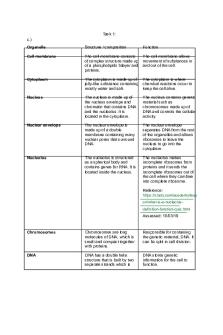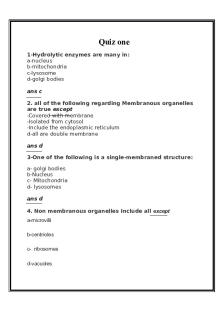Cell biology worksheet with answers PDF

| Title | Cell biology worksheet with answers |
|---|---|
| Course | Biology 120 |
| Institution | University of Saskatchewan |
| Pages | 3 |
| File Size | 141 KB |
| File Type | |
| Total Downloads | 80 |
| Total Views | 173 |
Summary
Worksheet from study session - good for practice ...
Description
In the space below, draw a picture of endocytosis in action. Label the intracellular and extracellular sides of the membrane. Google will be a great source of comparison to determine if your picture is accurate.
Using the diagram below, identify each organelle/structure.
(Image from: https://commons.wikimedia.org/wiki/File:Biological_cell.svg Author: MesserWoland and Szczepan1990)
1. Nucleolus 2. Nucleus 3. Ribosome (kinda hard to see but trust me) 5. Rough Endoplasmic Reticulum 6. Golgi Apparatus (or body, or complex) 8. Smooth Endoplasmic Reticulum. 9. Mitochondria 13. Centrosome; has not been covered, may have been mentioned in the textbook.
Out of the options below, name the organelle or cellular location where the function occurs. A. Protein Synthesis On ribosomes; found in either the mitochondria, chloroplast, cytoplasm, rough ER, or outer nuclear membrane. B. Carbohydrate Metabolism Cytoplasm C. Detoxification Smooth ER D. Lipid synthesis Smooth ER E. Addition of carbohydrate groups to proteins to produce glycoprotein (glycosylation) Rough ER, Golgi Apparatus F. Regulation of intracellular calcium levels Smooth ER (called the Sarcoplasmic Reticulum in muscle cells, where calcium levels are VERY important). What is the difference(s) between the small and large ribosomal subunits? Small subunit reads mRNA molecules, large subunit catalyzes peptide bonds between amino acids that correspond to the information stored in the mRNA molecule. When two similar membranes touch, what happens? What processes does this phenomenon allow to take place? The membranes will fuse. This allows processes such as exocytosis and phagocytosis to occur. What is the cis face of the Golgi Complex, and where do the proteins that enter there come from? How about the trans face? Proteins that enter on the cis face of the golgi complex likely came from the rough ER. Proteins will usually leave via the trans face if they are being exported out of the cell, although it is unlikely that proteins enter at the trans face. Will you find lysosomes in both animal and plant cells? What is the purpose of a lysosome? Only animal cells. Contains hydrolytic enzymes responsible for digesting cellular wastes. What is the purpose of a nuclear pore complex? What protein makes up one of these complexes? Allows selective transport of large molecules in/out of the nucleus. They are made up of proteins called nucleoporins. Suppose a protein was synthesized on a RER-bound ribosome. Where will this protein go next? It would likely be transported to the Golgi Apparatus for further processing. You are viewing an organism through an electron microscope. You locate a Golgi apparatus and a smooth endoplasmic reticulum. What can you infer about this organism, based on your observations? Based on the information given, we can infer that because it has membrane-bound organelles, that it is a eukaryotic cell. We cannot tell anything more than that base on the information. What is unique about the nucleus in Escherichia coli? It is unique in that it doesn’t exist. E. coli is a bacterium, and therefore has no membrane-bound organelles.
What kind of cells would have a high concentration of mitochondria? Eukaryotic cells that have a high energy demand, such as muscle cells, sperm cells, root cells of plants, etc.
What is some of the evidence suggesting that mitochondria and chloroplast were once prokaryotic organisms that were separate from their host? Have their own genome (that is similar to modern bacterial genomes), and therefore can produce their own proteins. They have a circular chromosome (as opposed to a linear chromosome in eukaryotic cells).
Cytochrome B is a protein that exists in the inner mitochondrial membrane and is an important structure in the electron transport chain utilized during the process of cellular respiration. Where might this protein be synthesized? Be specific. By a ribosome in the mitochondrial matrix.
Suppose a bacterial toxin enters a cell via the endocytic pathway. The vesicle that forms (containing the toxin) then fuses with a lysosome. What is likely to happen next? The lysosome will degrade the bacterial toxin with its hydrolytic enzymes.
What would you expect to happen if a lysosome burst in the cytoplasm of a cell, releasing its contents? Nothing. Intracellular pH is generally ~7.4, whereas the lysosomal enzymes require a pH of ~4.5 to function effectively. pH works on a logarithmic scale, and therefore a pH difference of almost 3 represents a H+ ion difference of 103, or approx. 1000x difference in H+ content.
What are the seven characteristics of life? Respond to external stimuli, exhibit homeostasis, harness and utilize energy, grow and divide, reproduce, displays order, and evolves....
Similar Free PDFs

Cell biology exam, answers
- 11 Pages

Cell potential worksheet+answers
- 4 Pages

Biology Quiz with answers
- 18 Pages

Protein Worksheet with Answers
- 4 Pages

Cell biology
- 3 Pages

Cell Biology Quiz CELL ORGANELLES
- 10 Pages
Popular Institutions
- Tinajero National High School - Annex
- Politeknik Caltex Riau
- Yokohama City University
- SGT University
- University of Al-Qadisiyah
- Divine Word College of Vigan
- Techniek College Rotterdam
- Universidade de Santiago
- Universiti Teknologi MARA Cawangan Johor Kampus Pasir Gudang
- Poltekkes Kemenkes Yogyakarta
- Baguio City National High School
- Colegio san marcos
- preparatoria uno
- Centro de Bachillerato Tecnológico Industrial y de Servicios No. 107
- Dalian Maritime University
- Quang Trung Secondary School
- Colegio Tecnológico en Informática
- Corporación Regional de Educación Superior
- Grupo CEDVA
- Dar Al Uloom University
- Centro de Estudios Preuniversitarios de la Universidad Nacional de Ingeniería
- 上智大学
- Aakash International School, Nuna Majara
- San Felipe Neri Catholic School
- Kang Chiao International School - New Taipei City
- Misamis Occidental National High School
- Institución Educativa Escuela Normal Juan Ladrilleros
- Kolehiyo ng Pantukan
- Batanes State College
- Instituto Continental
- Sekolah Menengah Kejuruan Kesehatan Kaltara (Tarakan)
- Colegio de La Inmaculada Concepcion - Cebu









